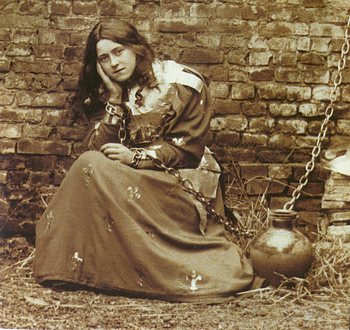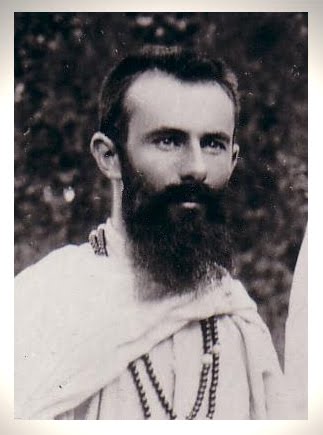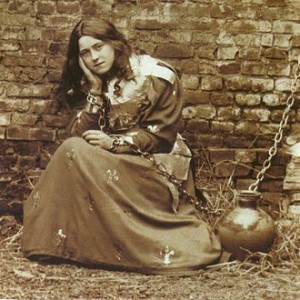Pope Francis recently made headlines saying that he had unexpectedly received a white rose which he took as a sign from St. Thérèse of Lisieux of her intercession. This incident reminded me yet again of an often overlooked but important side of the Little Flower: her great love for priests. Here’s a small glimpse into that hidden side of her life:
 |
| St. Thérèse acting as St. Joan of Arc whom she greatly admired. |
At the solemn examination before her Profession, St. Thérèse stated that the reason she came to Carmel was simple: “I have come to save souls and, above all, to pray for priests.” Although she grew up loving to pray for sinners, she was astounded at having to pray for priests because she had thought that “their souls were without blemish.” Thérèse became consumed with a thirst for souls after undergoing her “complete conversion,” but, as she explained, she was not yet concerned with praying for priests: “I was concerned not with the souls of priests but with those of great sinners which I wanted to snatch from the flames of hell.”
Growing up, Thérèse was frequently in the presence of priests, but never was she more extensively exposed to the lives of priests than she was during her pilgrimage to Rome. The Martins traveled with seventy-five priests and through that prolonged exposure to clergy she made the discovery that “some of them were still men, weak and subject to human frailty, even though the sublime dignity of the priesthood raised them above the angels.” After this experience, she said she then understood the main purpose of Carmel:
What a wonderful vocation we Carmelites have! It us up to us to preserve the salt of the earth. We offer our prayers and penance for God’s apostles and we are their apostles, while, by word and deed, they bring the Gospel to our brethren. But I must stop writing about this, though I could go on writing about it for ever.
In the silent and hidden life of Carmel, Thérèse labored strenuously as an “apostle of the apostles,” preserving the sanctity of priests at every opportunity she was given and, thus, growing in sanctity herself. This activity perdured in Thérèse even up until the moment of her death, as she offered her last Holy Communion for a priest, Father Hyacinthe Loyson, who had fallen away from the Church and caused great scandal at the time. Thérèse said that the great aim of her life was to “pray for all the intentions of Christ’s vicar,” saying, “my brothers toil instead of me and I, a little child, well, I keep close by the throne of God and I love for those who fight.” Although she had a great affection for missionary priests, her prayers and sacrifices were for all priests, including those of diocesan priests:
I pray for everyone and do not forget ordinary priests whose ministry is sometimes just as difficult as that of missionaries preaching to the heathen. Like our Mother, Saint Teresa, I want to be “a daughter of the Church” and pray for all the intentions of Christ’s Vicar. It is a great aim of my life.
 |
| Thérèse had worked as a sacristan in Carmel for a short period of time and found great joy in being able to handle the sacred vessels of the altar for the Blessed Sacrament. She said she used to spend time staring at her reflection in the bottom of the chalice because, as she said, her features were “reflected in the place where the Blood of Jesus rested and where it will descend again.” |
On one particular occasion, she saw in a letter from a seminarian that her prayers and sacrifices were working. “Oh, what consolation this letter brought to me,” she said. “I saw that my sufferings were bearing fruit. Did you notice the sentiments of humility the letter expresses? It’s exactly what I wanted.” Thérèse joyously spent her time in Carmel dedicated to praying for priests and scattering the little flowers of her sacrifices on the divine throne for them as they labored in the vineyard.
In Thérèse’s short life, priests had enlightened her soul with their homilies, freed her from guilt in the confessional, offered her spiritual nourishment through their writings, and even launched her full sail on the tide of confidence and love. For Thérèse, the priest was essentially a man of the sacraments. As she prepared for her first confession, she recalled in her writings how she had asked her sister with childlike profoundness if she should tell the parish priest, Father Ducellier, that she loved him with all her heart since it was God she was going to speak to in his person. She did not end up telling Father Ducellier that she loved him, but she did leave the confessional extremely happy and desired to return on every major feast day, since going to confession was a real feast for her. Priests were very much at the center of Thérèse’s heart of love, even if they were at times more like painful thorns than loving fathers.
Thérèse especially viewed the priest as a man of the Eucharist. An expression of this and her great love for the Eucharist was her unique desire to be, among many other things, a priest: “If only I were a priest! How lovingly, Jesus, would I hold you in my hands when my words had brought You down from heaven and how lovingly would I give you to the faithful.” She did not express any doubt in the Church’s teaching on the priesthood (although some would like to think so), but rather recognized the profound dignity given to priests at being able to call Jesus down from heaven with a few simple words and then hold Him in their hands. Thérèse longed to be a priest because she simply longed to hold Jesus lovingly in her hands and then joyfully give Him out to the faithful like a priest. This was a simple manifestation of her vocation to love Jesus and make Him loved. Knowing that she would never be a priest, she found in Saint Francis of Assisi, who remained a deacon out of humility before the priesthood, the model she desired to emulate.
 |
| Maurice Bellière |
One additional desire that Thérèse had which she greatly cherished was one which she had thought could never be fulfilled: that of having a brother priest who would remember her at the altar every day. Her two brothers had died in infancy, but God would nevertheless fulfill her desire in Carmel by sending her not one but two men whom she could call brother priests.
The first brother she received was Maurice Bellière, a seminarian hoping to be a missionary. The unexpected fulfillment of her desire awoke in Thérèse a childlike joy. “For years,” she said, “I had never experienced this sort of happiness. I felt as if my soul had been reborn and as if some of its neglected strings had been touched.” Maurice became one of Thérèse’s first readers, and the ten letters she wrote to him are among the longest she wrote to anyone and account for sixty percent of the letters she wrote in the last four months of her life. In these treasured writings, written at the height of her spiritual life on earth, Thérèse encouraged Maurice in his struggles while at the same time giving him a whole course on her Little Way. Maurice cherished every word she wrote and found great spiritual nourishment in them saying, “The breeze that blows from the Carmel to refresh my feverish and tired head makes me a better person by renewing my fervor.”
The last letter Thérèse wrote was to Maurice, and as a testament to her great love for him, she left him her most cherished possession: her crucifix. Shortly after beginning her correspondences with Maurice, Thérèse received her second brother, a missionary named Father Adolph Roulland, to whom she also wrote but never developed the same deep personal relationship that she had with Maurice.
Maurice Bellière and Adolph Roulland were very close to Thérèse’s heart during her final months and days. She told her sister that when she prayed for them she did not offer her sufferings. Instead, she prayed, “My God, give them everything I desire for myself.” With these two men, Thérèse’s universal mission in the Church to help priests began and a small glimpse was given of the extraordinary work for priests that she would do upon her entry into heaven.
 |
| St. Thérèse shortly before her death. |
As Thérèse grew deeper in love with Jesus Christ during her excruciating period of suffering at the end of her life, she expressed in various ways her desire to make her Spouse more loved. In two particular moments, she communicated to her sisters what she would have done had she been a priest. On one occasion, she said, “Had I been a priest, I would have learned Hebrew and Greek, and wouldn’t have been satisfied with Latin. In this way, I would have known the real text dictated by the Holy Spirit.”
On a second occasion, from her own fervent love for Mary, she said: “How I would have loved to be a priest in order to preach about the Blessed Virgin! One sermon would be sufficient to say everything I think about this subject.” The sermons she had heard on Mary had not touched her, saying that priests were not explaining to the people how they could imitate her: “She prefers imitation to admiration, and her life was so simple!”
Taken out of context, these texts could be construed to portray Thérèse as somehow expressing a disagreement with the Church’s teaching on the priesthood, but in the context of her great love and respect for the priesthood, she is simply here implicitly exhorting priests, as a part of their munus docendi, to teach the people the depths of love found in Sacred Scripture and in the Blessed Virgin Mary. They were for her of invaluable spiritual strength, and she wanted priests to use their munus docendi to share these tremendous fonts of spiritual strength with their flocks.




Fr. Nathan,
Good post! So is the intercession for priests a big part of the Carmelites charism or was it more of a particular focus of St. Therese?
Great question Matt.
The uniqueness of the Carmelites makes it a little difficult to understand their charism. Unlike most religious orders which can point to one singular individual as their founder, the Carmelites view a group of hermits living on Mt. Carmel as the foundation of their order. From the beginning, it seems that the main focus of the order was on contemplation, Mary, and the Eucharist. A focus on praying for priests may have naturally flowed from these, but it does not appear that praying for priests was a specific focus of the order at the start. A brief glance at their first Rule of Life (http://carmelnet.org/chas/rule.htm) seems to indicate that as well.
As for Therese herself, it appears that praying for priests was an important aspect of the Carmel of Lisieux because she writes as if it is an important aspect of all of their lives there. She mentions that it was at her solemn examination before her Profession that she stated her intent in Carmel was to “save souls and, above all, to pray for priests,” but she does not mention if that was what all of the sisters said or if it was something specifically unique with her. There is a tremendous amount written on St. Therese and I have by no means even skimmed the surface of them all, but I haven’t found much of anything written on this aspect of her life or of this aspect of life in the Carmel of Lisieux, so I unfortunately can’t give a better answer than that.
No, that answered my question, thanks!